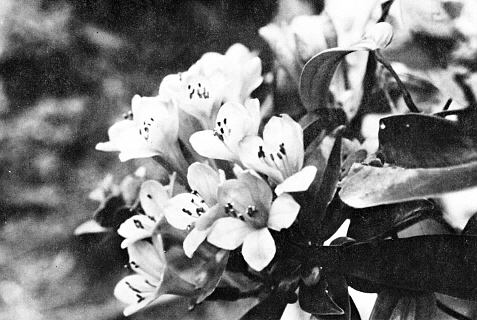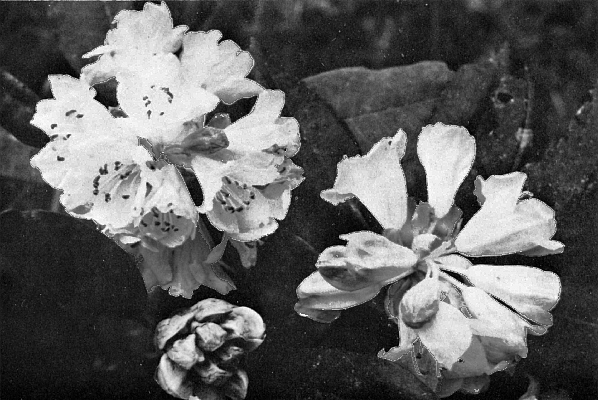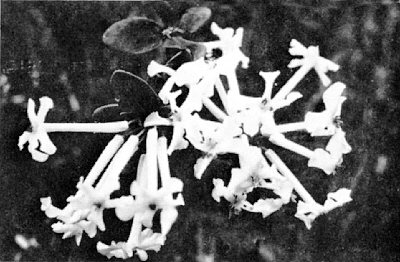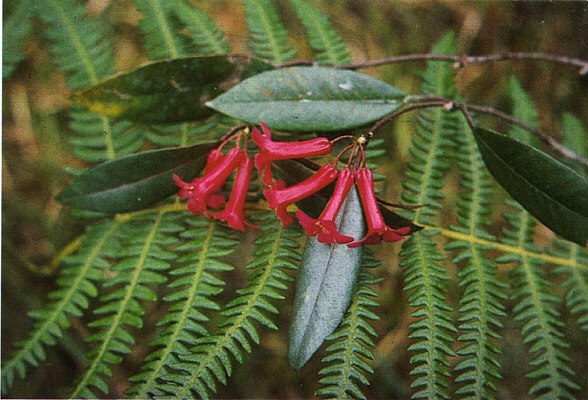A Note on Some Rhododendrons in Malaya
by Peter Valder
'A Botanical Excursion to Gunung Jerai' is the title of an article by H. N. Ridley (4) in which he described a visit undertaken in June, 1893, to this mountain, also known as Kedah Peak, which rises to 3900 feet on the coast of Kedah, opposite Penang. He went from Penang to the foot of the mountain by launch, spent the night in a fishing village and ascended the next day. He camped on the saddle between the two peaks, where he saw evidence of a rhinoceros and "very recent traces" of a larger tiger, together with species of
Dammara (Araucaria), Dacrydium, Podocarpus, Tristania, Banksia, Leptospermum,
and
Illicium
.
Ascending to the summit he collected upwards of fifty kinds of orchids and reported the biggest trees on the top to be a species of
Pieris
(now
Lyonia ovalifolia
). Although he did not find
Rhododendron jasminiflorum
or
R. malayanum
(Sect. Vireya), species already introduced to cultivation from Mt. Ophir by Thomas Lobb, he found a rhododendron about 12 feet tall which bore bunches of white flowers with yellow centres. He described this as a plant well-worthy of cultivation but found neither seeds nor young plants. He later named this species
R. leucobotrys
(6), a name now regarded as a synonym of
R. moulmainense
(Sect. Chonistrum) (9).
It is interesting to note that in the original description of
R. moulmainense
(2), based on. a plant raised from seed by Messrs Veitch, it is recorded as having come from "Moulmain, the Gerai Mountains". J. H. Veitch (13) states that it was detected there by Lobb who introduced it to Chelsea, where it flowered for the first time in January, 1856.
Since Thomas Lobb is known to have visited Gunung Jerai in 1845, it seems likely that this mountain in Malaya is the original locality from which
R. moulmainense
was collected. It is reported (12) that Lobb's specimens often bear incorrect localities, one botanist going as far as to suggest that the labels seem to have been purposely falsified in this regard. Not that this is surprising when one thinks of the highly competitive nature of plant collecting at the time.
In the light of all this, I took the opportunity when in Penang in December, 1974, to visit the mountain. There had been, not surprisingly, various changes. For a start, I was able to go by car to the top and back in one day, visiting Alor Star and driving almost to the Thai border as well.
The view from the top of the mountain was very striking, particularly since its situation close to the coast allowed one to look both down on the sea and across to Penang. The tiger and the rhinoceros were no longer in evidence, a group of Thai students were staying in a bungalow on the lower of the two peaks, and most of the
Lyonia ovalifolia
on the higher one had been eradicated by the construction of a radar station and television transmitter. This was being guarded by some youthful soldiers, who were camped nearby and who expressed great interest in my activities. They immediately drew my attention to a recumbent herb to which, amidst general laughter, they attributed the most awe-aspiring and long-lasting aphrodisiac powers. Being without faith I paid it no attention, but I later noticed that the driver of the car had collected a considerable amount of it.

|
|
R. moulmainense
from seed collected on Gunung Jerai
Photo by Peter Valder |
Apart from the areas occupied by the bungalow, the radar station, the soldier's camp, and the road, the vegetation of the mountain remained intact, as could be seen more clearly a couple of days later when I flew over it on my way to Thailand. The plants mentioned by Ridley were all there still. Lyonia ovalifolia occurred here and there and R. moulmainense was abundant from about 2900 feet to the summit, most bushes being about 12 feet tall as he described. The plants were not in bloom and only one of the many examined bore fruits. Vaccineum eburneum occurred near the summit, forming neat bushes with racemes of white flowers reminiscent of Zenobia , and small plants of R. jasminiflorum were common on the roadside banks, as was a white-flowered jasmine. Lower down, at about 2900 feet, were two bushes of a deep salmon form of R. longiflorum in full bloom.

|
|
R. longiflorum
Photo by Peter Valder |

|
|
R. wrayi
, 5 lobed form without spots
Photo by Peter Valder |

|
|
R. jasminiflorum
Photo by Peter Valder |
Another interesting Malayan plant is
R. wrayi
(Subsect. Irrorata). During the general excitement about the Malesian rhododendrons over the past twenty years or so, gardeners have failed to take much notice of the fact that Dr. Sleumer's monographic treatments of Malesian rhododendrons (10, 11) deals with a number of species other than those of the section Vireya, including three species of the subsection Irrorata. As far as I know only Michael Black (1) has drawn our attention to the possible usefulness of these species for the breeding of 'ordinary' rhododendrons for warmer climates. He collected seedlings of
R. wrayi
in Malaya and thus appears to be the first person to have brought one of these rhododendrons into cultivation. Hence it was with great interest that I drove up to the Cameron Highlands to have a look at the species for myself.
Michael Black (1) had already given a most interesting account of the area and its plants and, as I expected from his descriptions, I had no difficulty, even though I had only one full day at my disposal. My visit may have been well timed, however, as the jungle paths around Tanah Rata, which used to be kept in order by the British Army, looked as if they might become overgrown.

|
|
R. malayanum
Photo by Peter Valder |
I was pleased to find that a number of rhododendrons were abundant between 5000 and 5500 feet, and were in both flower and fruit.
R. jasminiflorum
, with heads of 6-20 scented, white flowers with bright pink stamens, styles and stigmas, was abundant, as was
R. malayanum
with groups of 3-4 small, pendulous flowers of shining scarlet.
R. javanicum
var.
teysmannii
bore almost ripe fruits and a few withered corollas, which looked as if they may have been yellow. Apart from numerous orchids, other plants of note were
Agapetes scortechinii
, a scrambling shrub with fleshy leaves and rose-red bell-shaped flowers, and a species of
Callicarpa
with glistening mauve berries. However it was the finding of large numbers of
R. wrayi
with both flowers and ripe capsules that provided the chief excitement of the day.
R. wrayi
was described in 1905 by King and Gamble (3) from specimens collected between 3500 and 7000 feet in Perak by Mr. L. Wray and Father Berthold Scortechini. Leonard Wray was appointed Superintendent of the Government Hill Garden in 1881 and Curator of the State Museum. Taiping, in 1883, retiring in 1908, and Father Scortechini was a missionary who came to Malaya sometime before 1884 from Australia, where he had previously collected plants. He lived at the Perak Residency, obtaining many plants which have never been re-collected, and died in 1886. Hence it is clear that R. wrayi must have first been collected about 20 years prior to its being named and described.
King and Gamble described it as a bush with inflorescences of 8-12 flowers, each 1.25 inches long and rather more across, 5-lobed, white tinged with pale pink, and with 10 stamens. They also described
R. dubium
from fruiting specimens obtained by the same collectors at 3400 feet, noting it to be shrub or small tree with umbels of 3-8 flowers.
In 1908 Ridley (5) recorded the occurrence of
R. wrayi
in Pahang and noted that it also occurred in the Kedah, Selangor, and Perak hills. In 1909 (6) he described var.
elliptica
, a large shrub or small tree to 15 feet with pure white flowers and longer, narrower leaves, and in 1915 (8) var.
minor
, smaller in all its parts than the type originally described by King and Gamble.
From specimens obtained by Dyak collectors on Gunong Menkuang Lebah in Selangor in 1913, Ridley (7) described
R. coruscum
, a plant with inflorescences of 10-13 flowers, 4 cm long and 5 cm wide, noting that they appeared to have been white with perhaps some dark coloring at the base of the tube. In an editorial note following Ridley's description, H. C. Robinson stated that "This handsome rhododendron is the dominant plant in the rainforest, just below the comb of the ridges. It is a small lanky tree growing to about 25 feet, whereas
R. wrayi
, which is found on the hills above Semangko Pass, is a short compact shrub growing on the actual summit in exposed situations. The flowers of the present species are somewhat translucent white, the tube at the base speckled with dark purplish".
R. coruscum
,
R. dubium
,
R. wrayi
var.
ellipticum
and
R. wrayi
var.
minor
are all included in
R. wrayi
by Sleumer (10, 11), who examined numerous specimens and paid a visit to the Cameron Highlands. He illustrated it (1) as having a 5-lobed corolla, extended the range of corolla length up to 4.5 cm, and described the plant as a compact shrub or small lanky tree 3-6 (-12) m tall. He recorded its occurrence at (855-) - 2165 m and reported that it is locally plentiful, as in the Cameron Highlands where it is sometimes dominant below the comb of the ridges.
As a result of having read all these things I was prepared to find it to be very variable. However none of the descriptions had led me to expect that most of the forms occurring around Tanah Rata would have inflorescences of 12-14 flowers, that they would be quite as large as those described for
R. coruscum
, and that on most plants the corollas would be 7-lobed. A few plants bore 5-lobed corollas and there were usually 10-12 stamens regardless of the number of corolla lobes. The amount of spotting was likewise variable, ranging from few to many and in colour from orange-red to purple. The first plant I found was not in bloom but bore inflorescence buds which when dissected were seen to contain as many as 18 individual flower buds.
The flowers are similar in effect to those of
R. morii, R. pseudochrysanthum
, and the Japanese members of the Ponticum series. Since the inflorescence buds appear to pen sporadically it is doubtful whether the plants ever make a massive display, but it would be unwise to generalize on the basis of one day's observation in the flowering season.
Most plants seen were 10-20 feet tall, although on the descent from Gunong Jasar to Tanah Rata there was a stand of trees 30, 40 and perhaps 50 feet tall, which would not have been recognized as rhododendrons were it not for the fallen corollas, since their first branches were high amongst the forest canopy.
Seeds were collected of all the Rhododendron species seen in Malaya and also those of
Lyonia ovalifolia
and
Agapetes scortechinii
. Seedlings have been successfully raised and many have flowered, including
R. wrayi
. This has been used in a few crosses from which it is hoped 'ordinary' rhododendrons suitable for warm climates may be raised.
The flowering of
R. moulmainense
has also been interesting. The flowers, though small, are produced in groups of three or four from each inflorescence bud but, since these buds are produced in groups of four or five, clusters of 16-20 flowers are not uncommon. They are fleshy in texture, white with some yellow at the base of the three upper petals, have a scent similar to that of jonquils, and resemble very closely those depicted in the plate accompanying the original description
REFERENCES
1. Black, M., (1969), Rhododendron and Camellia Yearbook 1970, 93-110.
2. Hooker, W. J., (1856), Bot. Mag., t. 4904.
3. King, G., and Gamble, J. A., (1905), J. As. Soc. Bengal 74, 75, 78-79.
4. Ridley, H. N., (1900), J. Str. Br. Roy. As. Soc., 34, 23-30.
5. (1908), J. Fed. Mal. St. Mus., 2, 107-142.
6. (1909), J. Fed. Mal. St. Mus., 4, 1-98.
7. (1914), J. Fed. Mal. St. Mus., 5, 28-50.
8. (1915), J. Fed. Mal. St. Mus., 6, 127-202.
9. Sleumer, H., (1958), Blumea, Suppl. 4, 58.
10. (1960), Reinwardtia 5, 45231.
11. (1966), Flora Malesiana Ser. 1, 6, 473-675.
12. van Steenis, C. G. G. J., (ed.), (1950), Flora Malesiana, Ser. 1. Vol. 1. Noordhoff-Kolff N.V., Jakarta.
13. Veitch, J. H., (1906), Hortus Veitchii, London.